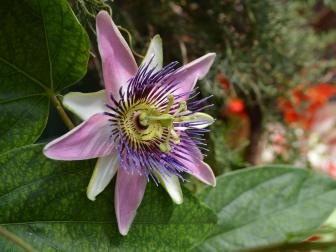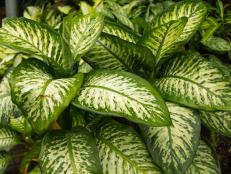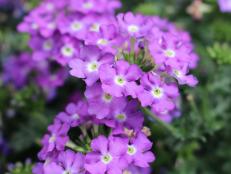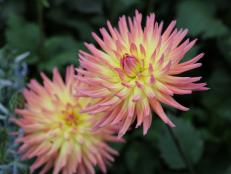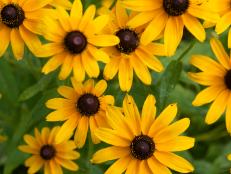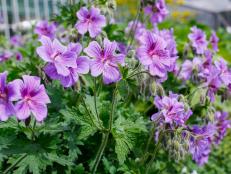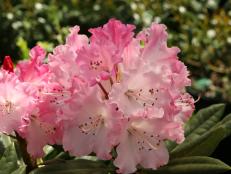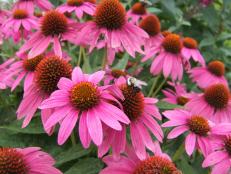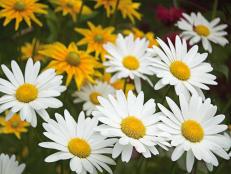Mandevilla Plant Care
The classic mandevilla vine brings a splash of bright, beachy color and big, tropical flowers to sunny spaces in the garden.


Mandevilla is the quintessential tropical vine. It's fast-growing, sun-loving and eager to twine up any trellis or wall and produce tons of big, bright flowers. Mandevilla is a popular choice for containers, with its showy red, pink and white flowers giving a lush tropical vibe to patios, porches and decks that are a long way from the beach.
Here's what you need to know about growing a mandevilla plant.
Mandevilla 101
Mandevilla is native to Central and South America. It's named for the English diplomat and amateur botanist Henry Mandeville who found this pretty, blooming vine growing in forests in Argentina in the late 1830s. He named it dipladenia and sent a sample home to England, but the plant's name was changed a few decades later to honor him.
In the nearly two centuries since it appeared in European and American gardens, mandevilla has become a popular plant. There are a lot of reasons it's beloved: Mandevilla is low maintenance, disease- and pest-resistant, fast-growing and a prolific bloomer. Plant one in a pot in April, and you'll have a towering vine covered in fragrant flowers all summer. Mandevilla is a perennial in its ideal growing zones of 9 to 11, but it dies when exposed to freezing temperatures. For that reason, it's grown as an annual in most places in the United States. If you live in a place where it freezes, you can keep your mandevilla alive by bringing it indoors for the winter.
Botanical Name: Mandevilla spp
Common Name: Mandevilla, rocktrumpet, Brazilian jasmine
Bloom Time: Summer, fall
USDA Hardiness Zones: Perennial in 9 to 11, can be grown as an annual in colder areas
Planting Mandevilla
Mandevilla thrives in full sun. Plant one where it gets less than 6 hours a day of direct sunlight and you won't get as many flowers. If you live in a hot place (hello Phoenix and Austin) mandevilla will tolerate, even appreciate, some shelter from the sun during summer afternoons. If you grow mandevilla vines in a pot, you can move the plant under a patio roof or shade tree to keep its leaves from getting scorched.
Mandevilla needs soil that is well draining. They can get root rot in heavy soil. They like loose soil that has lots of organic material mixed into it.
Water after planting and then keep the soil damp but not soggy. Unlike a lot of blooming plants, mandevilla can tolerate some dryness and keep flowering. They do appreciate consistent moisture, though, so don't let the soil dry out completely between waterings.
Mandevilla looks great in containers. Put a vining variety in a pot and train its vines up a porch post or along a balcony. You'll have rafts of shiny green leaves and flowers all summer long. Plant a shrubbier variety in a hanging container, and hang it from the rafters of your front porch. Vines of flowers will spill over the sides of the container and make your outdoor space look straight out of the Caribbean.

Costa Farms
Mandevilla 'Sun Parasol Crimson'. Mandevillas create a tropical feel in container gardens. Older types are vining plants that can grow on trellises and mailboxes, but some newer varieties form mounds instead and don’t require supports.
Caring for Mandevilla
Prune mandevilla vines at least once a year to keep the plant tidy and blooming. They're fast growing, so you're going to need to grab your clippers and keep this baby from taking over, unless, like Hilton Carter and me, you dig gardens that look like nature is in control instead of humans. The best time to cut mandevilla back is winter or early spring, before it starts blooming. Mandevilla blooms on new growth, so trimming it too late could deprive you of flowers. Don't trim more than a third of the plant at a time. You can cut off diseased or damaged branches anytime, and you should to keep your mandevilla healthy.
Colorful Climbers 12 Photos
Want vertical interest in your garden? All it takes is a simple trellis and a beautiful vine. Try one of these for easy-growing good looks.
Mandevilla needs warm temperatures and high humidity. It's tropical, after all. Mandevilla plants are happiest in places where nighttime temperatures don't go below 40 degrees. A hard freeze will kill them. Bring them indoors if they're in a pot. If you live in a dry climate or you're growing them indoors, mist their leaves regularly to keep humidity levels high enough to help them live their best life.
Fertilize mandevilla in the spring. Feed them before they start blooming, because producing flowers takes a lot of nutrition. You can also use a half-strength liquid fertilizer on your mandevilla every two weeks during their blooming season to keep them looking their best.
Mix compost into the soil. Whether they're in a pot or in the ground, your mandevilla plants will benefit from the addition of organic material to the dirt they're growing in. Fertilizer is great, but there's no substitute for good dirt. Don't have a compost pile? Enrich the soil with leaf mold, wood chips or worm casings.
Mandevilla Pests and Diseases
Mandevilla is relatively disease- and pest-free when grown outdoors in proper conditions. But if you bring mandevilla indoors for the winter, it can be vulnerable to whiteflies, aphids, scales, spider mites and mealybugs. Even the hardiest tropical plants can struggle when they have to spend months indoors, away from their natural environment. If your mandevilla gets an infestation, whip out the neem oil or insecticidal soap and spray the plant's foliage and blooms until all the bugs are gone. It will take a few applications and some patience.
Recommended Types of Mandevilla
Initially, all mandevilla were vining plants. But horticulturists have bred newer varieties that are shorter and bushier, making them better suited to containers and hanging baskets. Older varieties of mandevilla tend to have bigger leaves with a rougher texture. New varieties have smaller, glossier leaves that let mandevilla flowers be the star of the show. There are more than 100 species of mandevilla. Here are some of our favorites:
'Alice Dupont' mandevilla is the classic vining variety grown for its big pink flowers and big, textured leaves. Vines can grow as tall as 20 feet. It's named for the wife of Gilded Age businessman Pierre S. du Pont who created Longwood Gardens outside of Philadelphia.
'Sun Parasol Crimson' is a red mandevilla that produces red flowers on a semi-bushy plant that can reach 15 feet tall. There's a whole series of Sun Parasol mandevillas bred by the Japanese company Suntory, with blooms ranging from white to deep reds.
'Pink Parfait' (Mandevilla x amabilis) is a vining variety with double blooms in pale pink. It climbs to 20 feet tall.
'Red Riding Hood' (Mandevilla sanderi) has deep pink flowers with yellow throats on a shorter, shrubbier plant that only gets 12 feet tall.
Chilean jasmine (Mandevilla laxa) produces white flowers on a vine that reaches 15 feet tall.
White mandevilla (Mandevilla boliviensis) has white blooms and grows to 10 feet tall.






